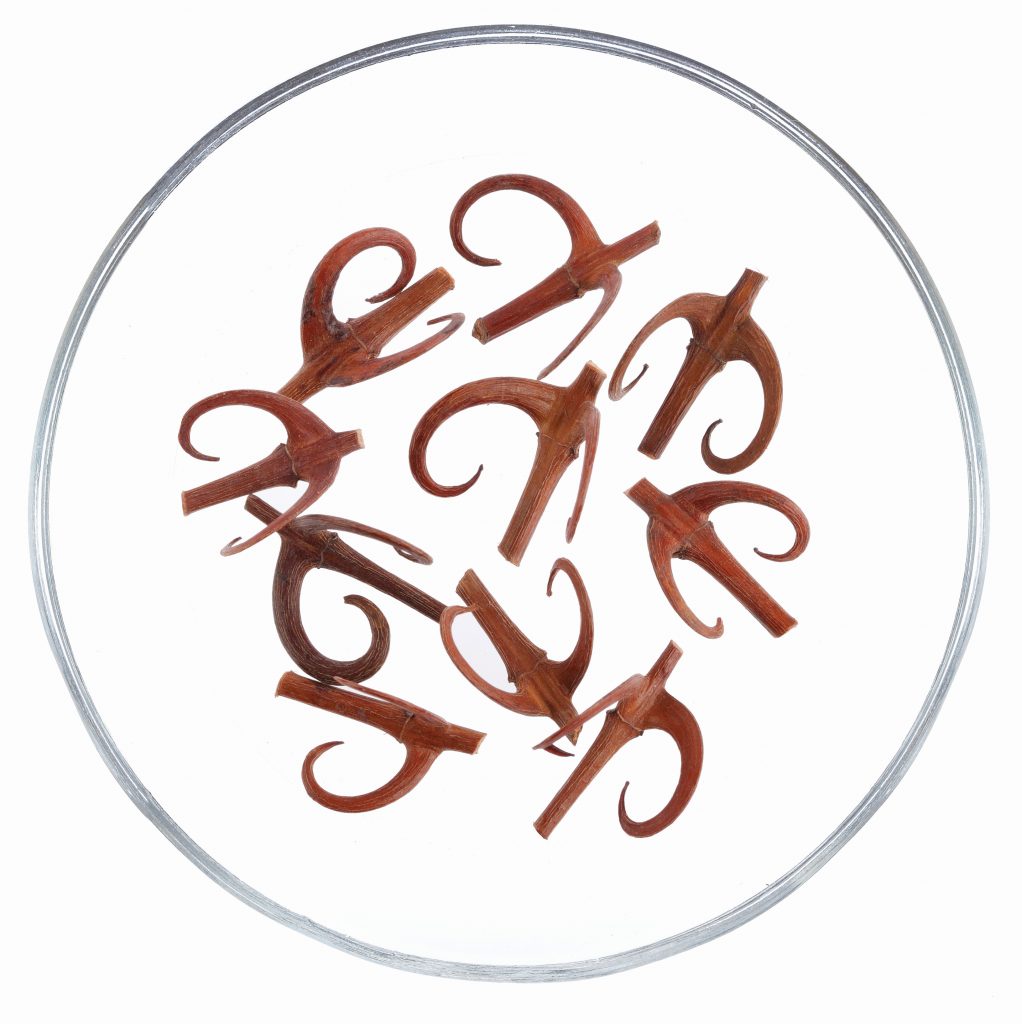Gambir Plant

What is Gambir Plant?
Gambir Plant (gou teng, 钩藤) also known as Gambir Sarawak, Uncaria Gambir or Cat Claw, is a woody climbing shrub that is native to China and other parts of Southeast Asia. It is made up of a thin, reddish-brown stem and broad green leaves. Most of the branches on the stem have hook-like appendages that the plant uses to attach itself to a surface.
Dr. Li Min, A Traditional Chinese Medicine (TCM) practitioner from Hong Kong Baptist University, published a research result that the combination of Gambir Plant with other herbs could be the cure to some ‘incurable’ diseases such as Irritable Bowel Syndrome (IBS) and Parkinson’s Disease. Since then, Gambir plant suddenly rose to popularity in the world of medicine.
Usually harvested during Autumn and Winter, the leaves are removed from the young twigs with hooks before the twigs are cut and dried under the Sun.
In TCM, Gambir Plant falls under the category of ‘Herbs that pacify Internal Liver Wind and stop Tremors’. Such herbs are used to treat hyperactive Liver yang, such as high blood pressure, seizures, spasms, convulsions, dizziness and vertigo. Cool in nature, Gambir Plant can help individuals who have too much Heat in their body, such as those experiencing a Yang Excess or a Yin Deficiency, to restore a healthy yin-yang balance.
Sweet in taste, Gambir plant (Gambir Sarawak) can slow down acute reactions, detoxify the body, and it has a tonic effect by replenishing qi and blood. In particular, the herb targets the Liver and the Pericardium.
Functions and Benefits of Gambir Plant
Traditional Chinese Medicine (TCM) shows that Gambir Plant has the following health benefits.
Gambir Plant can calm Liver Wind to relieve spasms, especially for Liver Wind caused by extreme Heat and infantile convulsions due to high fever. It can also be used for symptoms such as convulsive epilepsy, convulsions, muscle tremors and seizures.
Also, Gambir Plant can clear Liver Heat and sedate Liver yang. The herb can dilate peripheral blood vessels and lower blood pressure, which make it a form of treatment for hypertension, discomfort in the head, dizziness and anxiety, especially when these symptoms are caused by the up-flaming of Liver Fire or hyperactivity of Liver yang. Gambir Plant can also help to release the exterior to relieve fever, headache, and pink eyes.
In ancient times, Gambir Plant was used as a remedy for diarrhea too. The leaves and twigs were dried, crushed and brewed into tea for consumption. A modern study has proved that these leaves and twigs contain bacteria that can attack the bacteria which causes diarrhea in the colon. Aside from diarrhea, Gambir Plant can also relieve ulcer diseases, mouth disorders such as mouth sores, dry mouth and gum injuries.
In addition, Uncaria Gambir uses include treating burns as its chilling effect can help to make a speedy recovery and minimize scarring. Gambir Plant is also a great form of treatment for acne, as its antioxidants can heal wounds without leaving scars. The herb can also tackle various signs of premature aging such as dark spots, wrinkled skin and dull skin to give you firm and bright skin.

How to Use Gambir Plant
The recommended daily dosage of Gambir Plant is 3 – 12g. To prevent the active ingredients in the herb from being destroyed in the preparation process, you can decoct it later than other herbs that you are mixing it with.
Gambir Plant is most readily available in the form of Uncaria Gambir extract, which can be easily found in specialty stores and Asian markets. These extracts are made from the leaves and younger shoots of the Gambir Plant.
Cautions and Side Effects of Gambir Plant
Gambir Plant should not be used by individuals who are experiencing Qi Deficiency.
Also, excess amounts of Gambir Plant have been known to cause side effects such as Kidney damage, diarrhea, swollen feet and nausea. As the herb acts as a sedative, it may also enhance the effects of anesthesia for patients undergoing clinical procedures. The high tannin and catechin content in Gambir Plant may irritate the stomach and cause gastrointestinal pain too.
Hence, we do not recommend long-term or excessive usage of Gambir Plant, or any other plant that contains tannins. We strongly advise you to consult your healthcare provider before adding Gambir Plant to your diet.
Summary
Here is a summary for Gambir Plant (Gambir Sarawak):
- Herb name (Chinese): 钩藤
- Herb name (Pin Yin): gōu téng
- Herb name (English): Gambir Plant
- Herb name (Botanical): Ramulus Uncariae cum Uncis
- Origin of species: Uncaria rhynchophylla (Miq.) Jacks.; Uncaria macrophylla Wall.; Uncaria hirsuta Havil.; Uncaria sinensis (Oliv.) Havil.; Uncaria sessilifructus Roxb.
- Part(s) of herb used: Branch with hooks
- Geo-specific habitat(s): Fujian, Guangdong, Guangxi
- Taste(s) & Properties: Sweet; Cold; Administrates the Pericardium and Liver Meridians
- Actions: Eases headaches and dizzy spells; Relieves mild symptoms of influenza or related respiratory ailments; Eases symptoms of spasms and relating to hypertension
References
Munggari, I. P., Kurnia, D., Deawati, Y., & Julaeha, E. (2022). Current Research of Phytochemical, Medicinal and Non-Medicinal Uses of Uncaria gambir Roxb.: A Review. Molecules, 27(19), 6551. [Accessed on 4th November 2022]
Saad, M. F. M., Goh, H. H., Rajikan, R., Yusof, T. R. T., Baharum, S. N., & Bunawan, H. (2020). Uncaria gambir (W. Hunter) Roxb: From phytochemical composition to pharmacological importance. Tropical Journal of Pharmaceutical Research, 19(8), 1767-1773.[Accessed on 4th November 2022]
Share this article on
